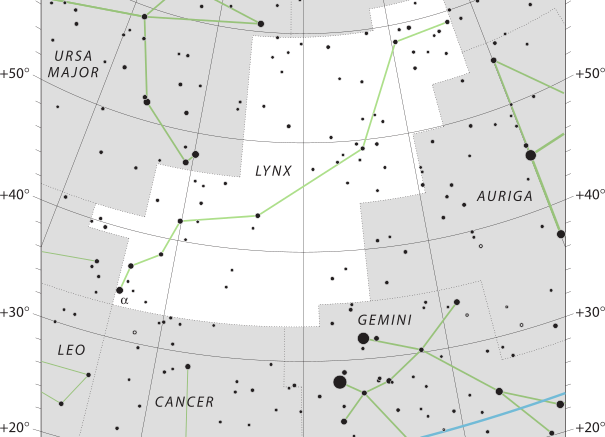Lynx is a constellation that is named after the animal, which can usually observed in the Northern Celestial Hemisphere. The constellation was introduced in the late 17th century by Johannes Hevelius. It is a faint constellation, with its brightest stars forming a zigzag line. The orange giant Alpha Lyncis is the brightest star in the constellation, and the semiregular variable star Y Lyncis is a target for amateur astronomers. Six star systems have been found to contain planets. Lynx covers 545.4 square degrees in the sky and covers 1.322% of the night sky, which makes the constellation ranks 28th of the 88 constellations in size. The whole constellation is visible to observers north of latitude 28°S.
Within the constellation’s borders lie interesting objects such as NGC 2419, the galaxy NGC 2770, the distant quasar APM 08279+5255, and the Lynx Supercluster.
| Applicable Information | |
| Visibility In Pacific Northwest | October to May |
| Best Times To View | March |
| Right Ascension | 5h |
| Declination | −65° |
| Area | 545 square degrees |
| Main Stars | 4 |
| Brightest Object | α Lyn |
| Meteor showers | Alpha Lyncids, September Lyncids |
| Messier objects | 0 |
| Neighboring Constellations | Ursa Major, Camelopardalis, Auriga, Gemini, Cancer, Leo, Leo Minor |
History
Polish astronomer Johannes Hevelius formed the constellation in 1687 from 19 faint stars between the constellations Ursa Major and Auriga. These stars had previously been part of an earlier had been part of the obsolete constellation Jordanus Fluvius. Naming it Lynx because of its faintness, Johannes challenged future stargazers to see it, declaring that only the lynx-eyed would have been able to recognize it. \
Hevelius used the name Tigris, which translates to Tiger, in his catalogue as well, but kept the former name only in his atlas. English astronomer John Flamsteed adopted the constellation in his catalogue, published in 1712, and his subsequent atlas. According to 19th-century amateur astronomer Richard Hinckley Allen, the chief stars in Lynx “might well have been utilized by the modern constructor, whoever he was, of our Ursa Major to complete the quartette of feet.”
Stars
English astronomer Francis Baily gave a single star a Bayer designation, which was to Alpha Lyncis, while Flamsteed numbered 44 stars, though several lie across the boundary in Ursa Major. Overall, there are 97 stars within the constellation’s borders brighter than or equal to apparent magnitude 6.5.
The brightest star in this constellation is Alpha Lyncis, with an apparent magnitude of 3.14.
Lynx’s most notable deep sky object is NGC 2419, also known as the “Intergalactic Wanderer,” as it was assumed to lie outside the Milky Way. At a distance of between 275,000 and 300,000 light-years from Earth, it is one of the most distant known globular clusters within our galaxy. NGC 2419 is likely in a highly elliptical orbit around the Milky Way.
NGC 2537, known as the Bear’s Paw Galaxy, lies about 3 degrees north-northwest of 31 Lyncis. It is a blue compact dwarf galaxy that is somewhere between 17 and 30 million light-years away from Earth.
The NGC 2841 group is a group of galaxies that lie both in Lynx and neighbouring Ursa Major. It includes the loose triplet NGC 2541, NGC 2500, and NGC 2552 within Lynx. Using cepheids of NGC 2541 as standard candles, the distance to that galaxy, and the group, has been estimated at around 40 million light–years. NGC 2841 itself lies in Ursa Major.
NGC 2770 is a type SASc spiral galaxy located about 88 million light–years away that has hosted Type Ib supernovae: SN 1999eh, SN 2007uy, and SN 2008D.
The Lynx Supercluster is a remote supercluster with a redshift of 1.26–1.27, which was the most distance known supercluster at the time of its discovery. There is the Lynx Arc, located around 12 billion light years away, which is a distant region containing a million extremely hot, young blue stars with surface temperatures of 80,000–100,000 K that are twice as hot as similar stars in the Milky Way galaxy.
Make sure to check out other articles on the site, including a brief introduction to constellations, other constellation articles, and more!

Be the first to comment on "Lynx"